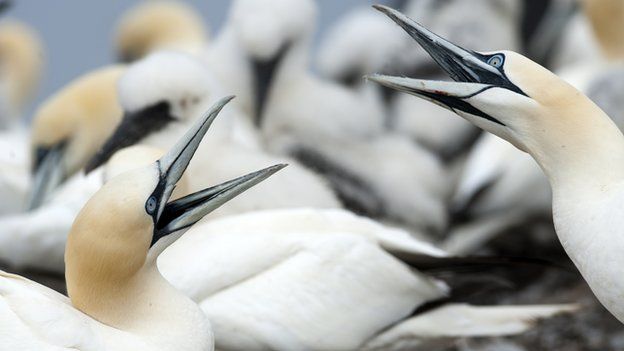Bass Rock has world's largest colony of Northern gannets
- Published

The Bass Rock in the Firth of Forth now has the world's largest colony of gannets following a count by experts.
There are more than 150,000 birds on the rock, 4km (2.5m) from North Berwick in East Lothian, which is an increase of 24% since the last count in 2009.
The northern gannets were counted using computers and images from the air.
Gannets travel south for the winter, many travelling as far as the coast of West Africa, and are due to return to the island within days.
The count was conducted last year and the figures compiled by Stuart Murray in conjunction with the Centre for Ecology and Hydrology.
Mr Murray said: "The colony was photographed from the air on 23 June 2014.
"Conditions were excellent, with no wind and a high cover of thick cloud which obscured the sun, reducing the glare from all these startlingly white birds.
"The images were later viewed on computer screens for counting and each occupied site was blocked-out as it was counted.
"Interestingly, the most dramatic increase is between the old lighthouse keepers' garden and the summit of the Rock.
"We counted around 10,000 sites in this area compared with 6,500 five years ago."
Sarah Wanless, from the Centre for Ecology and Hydrology, said: "Our long-term research on North Sea seabirds aims to understand how species such as the gannet will cope with the rapid pace of environmental change.
"This is our fifth census of the Bass Rock in the last 30 years.
"It is particularly heartening to see them doing so well when so many other seabirds in Scotland appear to be in trouble, however, the Bass Rock is a small island and the gannets have now filled most of the available nesting habitat.
"The colony now has only very limited capacity for further increase."
Tom Brock OBE, chief executive of the Scottish Seabird Centre, said: "Scotland is of international importance for seabirds and is home to over 60% of the world's population of Northern gannets.
"The figure of 75,000 sites is phenomenal especially when many apparently occupied sites will represent a breeding pair and their chick.
"I would expect that the total gannet population on the Bass in the breeding season will be well in excess of 150,000 birds.
"Every year the Bass Rock turns brilliant white with the sheer number of gannets crammed onto the rock and not, as some people think, with their guano."
Visitors to the Scottish Seabird Centre can control the interactive live cameras and zoom in on the live gannet action on the Bass Rock.
The Seabird Centre's boat trips to the Bass Rock start at Easter.
First records of gannets on the Bass Rock date back to the 15th century.
Gannets are Britain's largest seabird, with a wing span of over 6ft/1.8m. They can live over 30 years. They dive at speeds of up to 60mph/96kmph.
The Bass Rock was formed 320 million years ago and is the core of an old volcano.
It has been owned by the Hamilton-Dalrymple family for the last 300 years.
There is a lighthouse, built in 1902, the last keepers left in 1988 when the lighthouse was automated.